Mad Hedge Technology Letter
October 25, 2018
Fiat Lux
Featured Trade:
(HOW ENVIRONMENTALISTS MAY KILL OFF BITCOIN),
(BTC), (ETH), (TWTR), (SQ)

Mad Hedge Technology Letter
October 25, 2018
Fiat Lux
Featured Trade:
(HOW ENVIRONMENTALISTS MAY KILL OFF BITCOIN),
(BTC), (ETH), (TWTR), (SQ)

If Jack Dorsey's proclamation that bitcoin will be anointed as the global "single currency," it could spawn a crescendo of pollution the world has never seen before.
In a candid interview with The Times of London, Dorsey, the workaholic CEO of Twitter (TWTR) and Square (SQ), offered a 10-year time horizon for his claim to come to fruition.
The originators of cryptocurrency derive from a Robin Hood-type mentality circumnavigating the costly fees and control associated with banks and central governments.
Unfolding before our eyes is a potential catastrophe that knows no limits.
Carbon emissions are on track to cut short 153 million lives as environmental issues start to spin out of control while the world's population explodes to 9.7 billion in 2050, from 8.5 billion people in 2030, up from the 7.3 billion today.
All these people will need to barter in bitcoin, according to Jack Dorsey.
Cryptocurrency is demoralizingly energy-intensive, and the recent institutional participation in crypto server farms will exacerbate the environmental knock-on effects by displacing communities, destroying wildlife, and climate-changing carbon emissions.
This seemingly controversial means to outmaneuver the modern financial system has transformed into a murky arms race among greedy cryptocurrency miners to use the cheapest energy sources and the most efficient equipment in a no-holds-barred money grab.
Bitcoin and Ethereum mining combined with energy consumption would place them as the 38th-largest energy consuming country in the world - if they were a country - one place ahead of Austria.
Mining a bitcoin adjacent to a hydropower dam is not a coincidence. In fact, these locales are ground zero for the mining movement. The common denominator is the access to cheap energy usually five times cheaper than standard prices.
Big institutions that mine cryptocurrency install thousands of machines packed like a can of sardines into cavernous warehouses.
In 2015, a documentary detailed a large-scale foreign mining operation with an electricity outlay of $100,000 per month creating 4,000 bitcoins. These are popping up all over the world.
An additional white paper from a Cambridge University study uncovered that 58% of bitcoin mining comes from China.
Cheap power equals dirty power. Chinese mining outfits have bet the ranch on low-cost coal and hydroelectric generators. The carbon footprint measured at one mine per day emitted carbon dioxide at the same rate as five Boeing 747 planes.
The Chinese mining ban in January set off a domino effect with the Chinese mining operations relocating to mainly Canada, Iceland, and the United States.
Effectively, China has just exported a tidal wave of new pollution and carbon emissions.
Bitcoin is mined every second of every day and currently has a supply of approximately 17 million today, up from 11 million in 2013.
Bitcoin's electricity consumption has been elevated compared to alternative digital payment currencies because the dollar price of bitcoin is directly proportional to the amount of electricity that can profitably be used to mine it.
To add more granularity, miners buy more servers to maintain profitability then upgrade to more powerful servers. However, the new calculating power simply boosted the solution complexity even faster.
Mines are practically outdated upon launch and profitability could only occur by massively scaling up.
Consumer grade personal computers are useless now because the math problems are so advanced and complicated.
Specialized hardware called Application-Specific Integrated Circuit (ASIC) is required. These mining machines are massive, hot, and guzzle electricity.
Bitcoin disciples would counter, describing the finite number of bitcoins - 21 million. This was part of the groundwork laid down by Satoshi Nakamoto (a pseudonym), the anonymous creator of bitcoin when he (or they) constructed the digital form of money.
Nakamoto could not have predicted his digital experiment backfiring in his face.
The bottom line is most people use bitcoins to literally create money out of thin air in digital form, rather than using it as a monetary instrument to purchase a good or service.
That is why people mine cryptocurrency, period.
Now, excuse me while I go into the weeds for a moment.
Enter hard fork.
A finite 21 million coins is a misnomer.
A hard fork is a way for developers to alter bitcoin's software code. Once bitcoin reaches a certain block height, miners switch from bitcoin's core software to the fork's version. Miners begin mining the new currency's blocks after the bifurcation creating a new chain entirely and a brand-spanking new currency.
Theoretically, bitcoin could hard fork into infinite new machinations, and that is exactly what is happening.
Bitcoin Cash was the inaugural hard fork derived from the bitcoin's blockchain, followed by Bitcoin Gold and Bitcoin Diamond.
Recently, the market of hard fork derivations includes Super Bitcoin, Lightning Bitcoin, Bitcoin God, Bitcoin Uranium, Bitcoin Cash Plus, BitcoinSilver, and Bitcoin Atom.
All will be mined.
The hard fork phenomenon could generate millions of upstart cryptocurrency server farms universally planning to infuse market share because new currencies will be forced to build up a fresh supply of coins.
If Peter Thiel's prognostication of a 20% to 50% chance of bitcoin's price rising in the future is true, it could set off a cryptocurrency server farm mania.
By the way, Thiel also believes that there is a 30% chance that Bitcoin could go to zero.
A surge in the price of bitcoin results in mining cryptocurrency operations everywhere by any type of electricity, especially if the surge maintains price stability. Even mining in Denmark, where one finds the world's costliest electricity at $14,275 per bitcoin, would make sense.
Recently, miners' appetite for power is causing local governments to implement surcharges for extra infrastructure and moratoriums on new mines. Even these mines built adjacent to hydro projects are crimping the supply lines, and consumers are forced to buy power from outside suppliers. Miners are often required to pay utility bills months in advance.
By July 2019, mining will possibly need more electricity than the entire United States consumes. And by February 2020, bitcoin mining will need as much electricity as the entire world does today, according to Grist, an environmental news website.
Geographically, most locations around the world were profitable based on May's bitcoin price of $10,000.
However, the sudden slide down to $6,400 reaffirms why the Mad Hedge Technology Letter avoids this asset class like the plague.
The most unrealistic operational locations are distant, tropical islands, such as the Cook Islands at $15,861, to mine one bitcoin.
If you'd like to drop your life and make a fortune mining bitcoin, then Venezuela is the most lucrative at $531 per bitcoin.
As bitcoin's nosedive perpetuates, Venezuela might be the last place on earth with mining farms.
Who doesn't like free money? Set up a few devices, crank up the power, collect the coins, pay off the electricity bill, pocket the difference and hopefully the world - or Venezuela - hasn't keeled over by then.
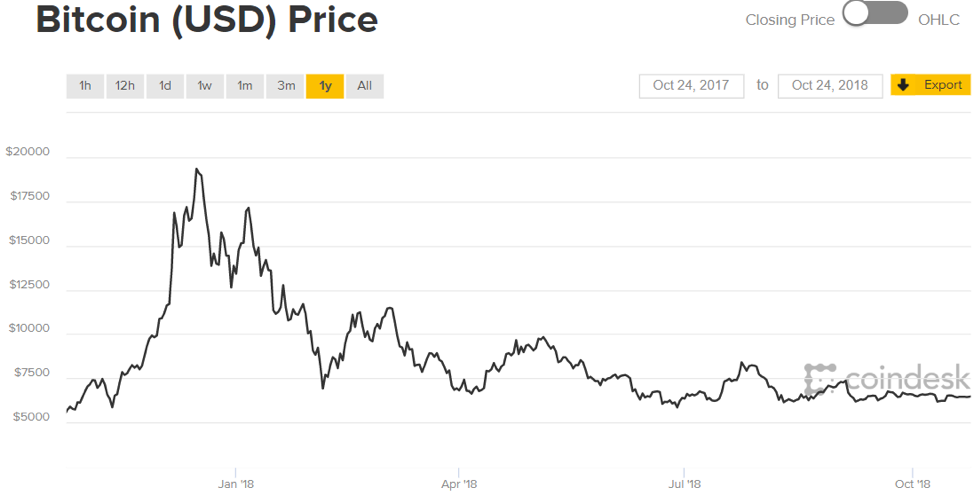
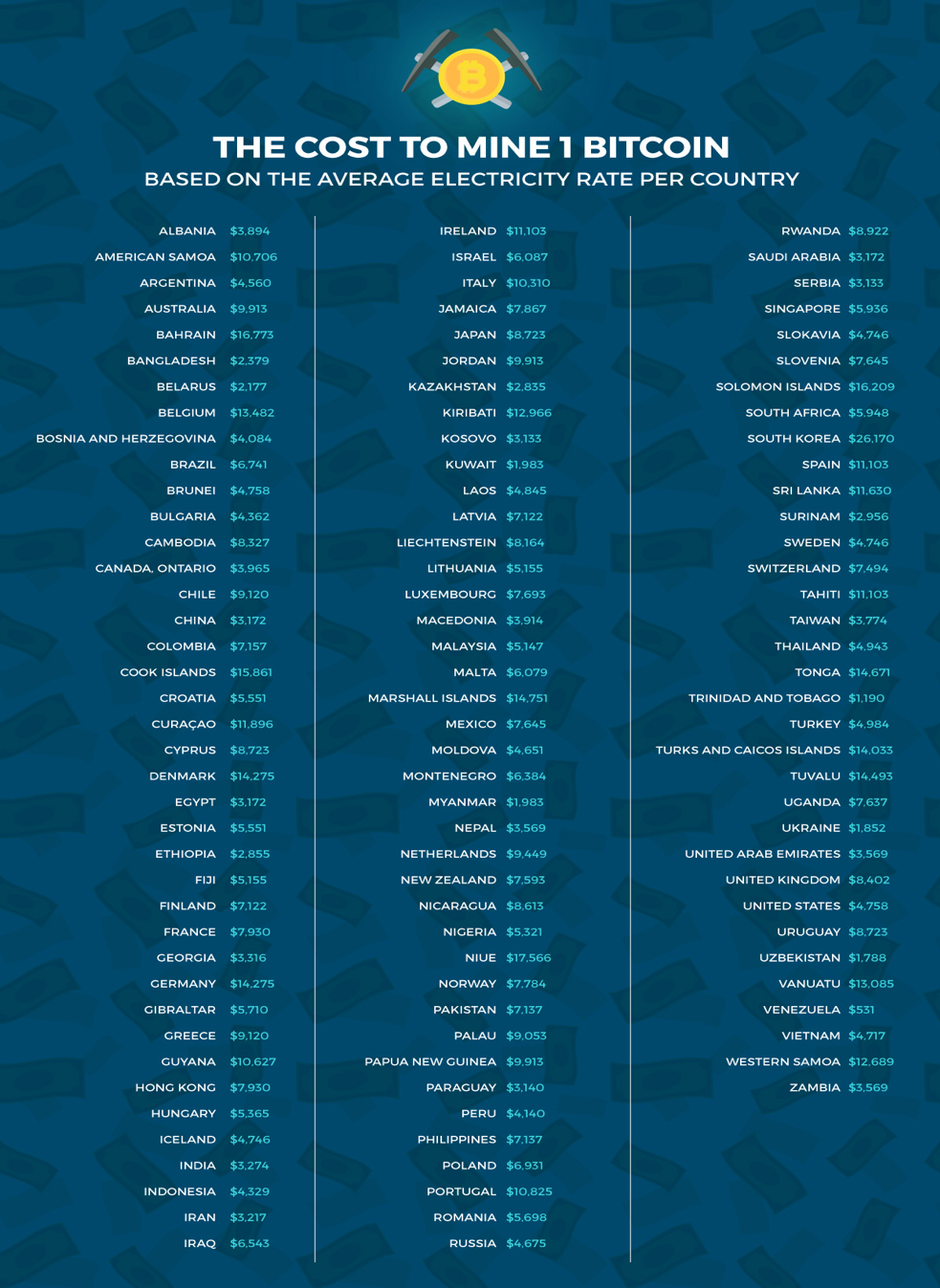

Mad Hedge Technology Letter
September 10, 2018
Fiat Lux
Featured Trade:
(GOOGLE’S BREAKFAST OF ROTTEN EGGS),
(TWTR), (FB), (GOOGL), (MSFT), (AMZN)

In a recent interview Google CEO Sundar Pichai admitted he is “not a morning person” and maybe that was his argument for skipping out on the grilling that his contemporaries Facebook (FB) COO Sheryl Sandberg and CEO of Twitter (TWTR) Jack Dorsey received in front of Congress.
Or maybe Pichai managed to down a rotten egg that morning when eating his favorite staple breakfast “omelet with toast," because his decision to abort his date with Congress was a shocking error of judgment for a CEO that has had a flair for controversy lately.
With the whole world watching, the empty chair with a simple name tag with Google plastered over it represents the arrogance and excesses of Silicon Valley all mixed into one incongruous mixture.
This rookie move will open a can of worms for the company made famous by its search algorithm that dominates the developed world.
Google will have a target on its back going forward while creating a massive public relations backlash for a company that must fiercely defend its ad-laden profit engine going forward.
Instead of taking it on the chin like Facebook and Twitter, Google has voluntarily veered into a sticky situation, and all to avoid a few stomach wrenching questions from Congress.
How did this all happen?
In the beginning of June, Google decided to scrap its relationship with the U.S. Department of Defense.
Project Maven, as it was known, provided Google’s artificial intelligence (A.I.) technology to systematically analyze drone footage for the U.S. government.
Pichai chose to avoid renewing the contract, and Google Cloud CEO Diane Greene agreed it was a black eye for the company that applied its own technology to conspire against damaging human life.
Throwing fat on the fire, Pichai followed up by dismantling Project Maven and giving the thumbs up for code-name Dragonfly. This was a secret project aimed at the mainland Chinese market and rolling out a censored version of Google’s search engine by altering its construction of unique search algorithms for a mainland Chinese audience.
This incensed the higher-ups on Capitol Hill, as this move was largely viewed as pandering toward the Chinese communist government for monetary purposes at an uber-sensitive time between the two powerhouse nations, which remain mired in a tumultuous trade war.
The timing couldn’t be worse for Pichai.
Dragonfly is already in beta mode and could be rolled out in the near future. However, I see it as dead on arrival, because there is no hope that Google can penetrate the fortress that is the Chinese business world.
Naturally, Google employees were dismayed and shocked by these startling revelations.
Pichai’s conspicuous no-show was in part driven by the potential wrath he would have faced by these recent reckless decisions that seemed to put the American government’s interests below the Chinese communist government.
The circus was there for everyone to see.
Sheryl Sandberg put on her bravest face.
It was obvious she had rehearsed every word to the utmost precision while Dorsey vehemently guarded his brainchild with honesty and zeal.
The testimonies made social media look perceivably criminal with a congressman even hinting the reason they aren’t allowed to do business in China was mainly a business model issue, and more specifically a legal issue.
Another congressman from West Virginia suggested Facebook’s Instagram was the source of the opioid epidemic ripping apart his state.
The only thing getting ripped apart during the intense grilling was Sheryl Sandberg’s well-practiced smile.
Dorsey and Sandberg were visibly uncomfortable with the line of questioning and rightly so.
Google would have looked worse if it showed up. But it managed to look 10 times worse than that by stonewalling the government’s invitation.
In a recent Pew Survey, data revealed 44% of youth between 18 to 29 last year deleted Facebook on their mobile phones.
Facebook is already a legacy platform in the throes of disruption cannibalized by its own asset - Instagram.
Instagram will be the sole survivor of Facebook by taking out Facebook itself, and that is bearish for overall business.
And that is if social media can hang on that long before it’s taken down by the hawks circling above in Washington.
When Facebook’s Cambridge Analytica scandal broke, the government was at sixes and sevens at attempting to figure out what on earth was going on behind the smoke and mirrors of the big data theatrics.
CEO Mark Zuckerberg was let off the hook with questions he wriggled out of, and Facebook shares powered on unabated.
This time it’s different.
Regulation is an imminent threat to social media revenues and could hurt earnings this quarter.
Investors need to migrate to higher tide, meaning Amazon (AMZN) and Microsoft (MSFT), because the waves still aren’t yet reaching those levels.
Amazon and Microsoft need to send a thank you note to Alphabet for screwing the pooch.
The administration has felt it convenient to barrage Silicon Valley to solidify the Republican base, and this tactic has resonated with the administration’s diehards.
A smorgasbord of FANG-bashing was the recipe to this madness. But now sights will be zoned in on dismantling Google, and Microsoft and Amazon will benefit from avoiding nasty, gut-churning headlines that turn up in the form of Twitter blitzkrieg.
Yes, Sheryl Sandberg, Facebook was “too slow” to react to foreign interference in the elections. But it is more accurate to characterize the battle social media faces against outside nefarious forces as impossible.
It is impossible for these social media platforms to police themselves while policing the whole world.
The incessant whack-a-mole scenario is the best-case outcome for the self-policing prospects of social media.
Once social media algorithms figure out how to stopgap one method of circumvention, the bad actors will move on to a more advanced way to manipulate the algorithmic police.
What does this mean for social media?
Costs are going up and will seep into profit margins.
Highlighting the upward trend of rising expenses for social media platforms is the daily cost of keeping CEO Mark Zuckerberg safe.
And remember, he lives in Palo Alto, California, one of the safest places on planet earth with a medium household income of $137,000.
In 2017, Facebook divvied up $7.3 million for Zuckerberg’s security detail and costs associated to it.
In 2018, shareholders approved a $10 million security package to keep Facebook’s head honcho safe. This underscored the ballooning risk of leading this controversial technology forum littered with conflict of interests, and on the verge of potentially perverting western democracy.
By the end of 2018, Facebook will increase its security division from 10,000 employees to 20,000.
And that is just the beginning.
Facebook’s security division is the fastest-growing division of fresh hires at Facebook.
Before Facebook and Twitter can ring in the profits, they face an exorbitant war against foreign “bot armies” intent on muddying the free flow of accurate information on domestic shores that target individuals deemed unaligned to the foreign actor’s interests.
There will be collateral damage and lots of it.
This does not sound like an easy road to profits, and it is not.
As midterm elections creep closer and closer, Facebook and Twitter must confront elevated headline risk, and any trading day could see shares wacked with a 10% haircut.
Following the government question-and-answer period, Twitter and Facebook will be designing a new resistance to stymie villainous foreign infiltration.
Ultimately, spending the bulk of employees’ work days realigning their business models to protect democracy, instead of creating new growth drivers, is not bullish for the stock price.
It is hard to breed much confidence in social media stock’s long-term narrative after listening to Dorsey and Sandberg speak.
They kept touching on needing help from government intelligence sources to aid them in catching the miscreants.
It makes sense to gradually nationalize social media platforms to unite the disconnect between social media’s war against foreign forces and the intelligence communities war against them.
It is clear hackers are exploiting the dislocation in cohesiveness between the cracks in social media and government intelligence.
But if that ever happens, it would be the end of Facebook and Twitter as we know it, as normal users would be averse to providing free content on a government-enabled platform as well as a strong blow to democracy itself.
It all makes sense now why Dorsey and Sandberg gave the answers they gave.
Their answers were akin to a faint plea for help while appearing contrite, hoping to persuade Congress to give them more time to figure it out.
This thinly veiled attempt to elongate the profit-making process and find a solution for a problem with no solution could end badly for these two companies.
Migrate to higher quality tech names in the short-term.
The resilient American economy powers on with the heavy lifting done by Silicon Valley albeit it with fewer lifters.
If social media stocks can get through the midterm elections unscathed, there is a trade on the table for these beleaguered companies rounding out a tumultuous year.
But getting to that point will be volatile, as this group of stocks have a rocky road ahead of them for the rest of the year.

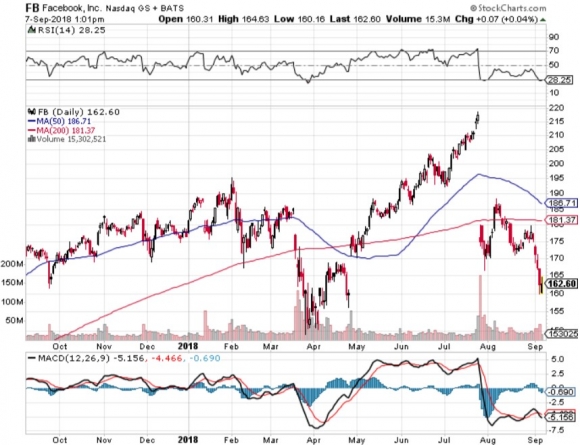


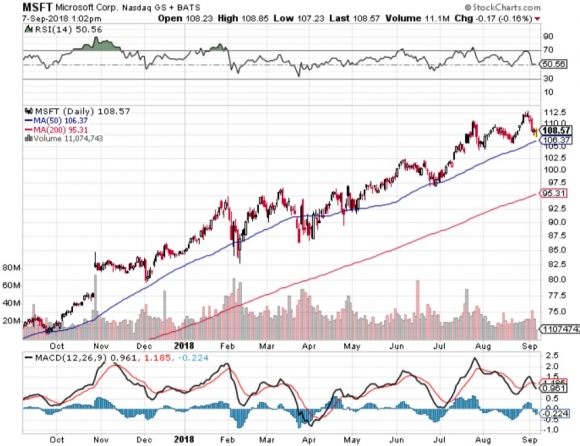
________________________________________________________________________________________________
Quote of the Day
“I'm not a regular smoker of weed. Almost never,” – said CEO of Tesla Elon Musk on The Joe Rogan Experience podcast.

Mad Hedge Technology Letter
August 30, 2018
Fiat Lux
Featured Trade:
(ON TRUMP’S TECHNOLOGY ATTACK),
(AMZN), (GOOGL), (FB), (AMD), (TWTR)

First Amazon (AMZN), now Alphabet.
In a strategic move to fortify his base ahead of critical midterm elections, the President of the United States Donald J. Trump has denounced tech behemoth Alphabet (GOOGL) describing search results using his name as “rigged.”
If Trump loses the midterm elections, it could open a can of worms and threaten his position.
It is no surprise that he plans to invest 40 days traveling around America campaigning for Republicans in November.
This is a big deal.
Silicon Valley has been a frequent bashing target for the White House.
The data privacy fiasco of 2018 has offered ample ammunition to pretty much anyone who wants to rain on big tech’s parade.
Big tech has experienced a wave of bad press shifting public opinion against them ruining future guidance for social media companies such as Facebook (FB).
How does the administration’s attack against Alphabet affect its stock price going forward?
It won’t even blink.
Alphabet’s stock barely budged after the President used his Twitter (TWTR) feed to sound off against the famous digital search engine company.
The stock closed down 0.83% on the day.
We have seen this story again and again with the administration lashing out at certain sectors or individuals, only for the stock market to shrug off any resemblance of weakness and power higher to new all-time highs.
Resiliency would be the best way to characterize this market.
Ironically, Trump found time yesterday to tweet that the Nasdaq had just surpassed 8,000 for the first time, showing off the tech strength underpinning the nine-year bull market.
The FANGs are front and center the stars of the show. Grumbling about a prominent member of this cohort will do nothing to stop the profit engines that tech companies have constructed.
Stellar corporate earnings are the secret sauce in this recipe and investors would be crazy to veer away from that.
Investors have no reason to panic because the tech narrative will not go away anytime soon, and the market knows that.
Political turbulence has been baked into the pie, and it would be eerie if the airwaves went silent.
Investors have largely avoided pinpointing non-economic issues and focused on the economy and its robust 4% growth rate.
It helps that the unemployment rate has fallen to 3.9%, and the full labor market is a net positive, even though inflation and wage growth has yet to contribute as much as initially hoped.
Of course, politics play a substantial role in influencing the stock market. But looking back at the past crisis, the stock market reacted the same as it will now and go much higher.
The market is still very much a tech story, and last week’s price action confirmed this.
The Mad Hedge Technology Letter is still net negative on chip stocks, but the two chip stocks that circumvent my negative calls are companies I recommended recently and that have seen a breathtaking leg up.
Not all chip companies are made equal and Advanced Micro Devices, Inc. (AMD) proved that by spiking 35% so far in August, 23% in the past week, and more than 140% this year.
The hockey stick move has seen (AMD) short sellers singed to a tune of $3 billion in 2018.
Chip stocks were supposed to get crushed by the weight of the trade war. However, these two stalwarts prove that if you are in the right names, you’ll avoid the carnage, which has beset many smaller chip companies that have the bulk of revenue tied to China.
Tech companies have bought back more than $1 trillion of their own stock since the beginning of 2009 because they have the money to do so.
Silicon Valley companies continue to purchase back their own stocks at a furious pace, putting a floor under many cash cow tech firms to the benefit of share prices.
Whether you want to believe or not, the market is metamorphizing into an all-tech story as every sector migrates to the cloud and the heavy use of big data.
Industrial giants are turning into industrial IoT companies.
Turn over any stone and you would be hard pressed to not find some sort of tech in new products.
Silicon Valley is on the cusp of rolling out its self-autonomous driving technology for commercial operations with Alphabet’s subsidiary Waymo.
If that wasn’t a good reason to buy Alphabet, then let’s review the other positive levers in their portfolio.
Alphabet is one member of a two-man team dominating digital advertising revenues with Facebook.
Global media spend is expanding at 13% YOY as the migration to mobile sees no end.
Google has the best search engine in the world. There are no competitors even close to supplanting its holy grail search engine business, unless you consider bing.com a worthy competitor, which it isn’t.
Data is the new oil, and Alphabet is able to douse itself in data because of the gobs it possesses.
This is the reason Google knows everything about most people in the world outside of China.
Alphabet will be able to leverage this enormous treasure trove of big data and monetize it using artificial intelligence technology.
Add it all up and Alphabet is massively profitable and positioned on the vanguard of every future groundbreaking technology in the world.
Picking on the big boys won’t do much, and the stock price will power on unabated for the foreseeable future.
As the midterm elections draw closer, Trump could also double down on his foreign exploits attempting to consolidate political capital.
That means virulently attacking China’s trade policy, which could go into overdrive as they could give him the source of expansive buffer for which he is looking.
However, it is a double-edge sword as many constituents in red states could be the recipient of higher costs that elevated tariffs would bring.
At the bare minimum, Trump has cast a light on China’s unfair trading policies that has tapped an uneasy nerve for many other countries quietly agreeing with the American president.
This could create a whack-a-mole scenario as China could experience growing problems with numerous undeveloped countries felt wronged, and these headaches could take on different forms such as the Forest City project in Malaysia.
Back in the equity world, the smaller chip companies are baring the brunt of the administration’s scathing rhetoric toward China, but the economy, stock market, and consumer health will hum along as if nothing happened.
The damage is limited, giving Trump sufficient leeway to speak out about side issues as the vital midterm elections roll around.
The bull market is not close to dying and there is still room to run.
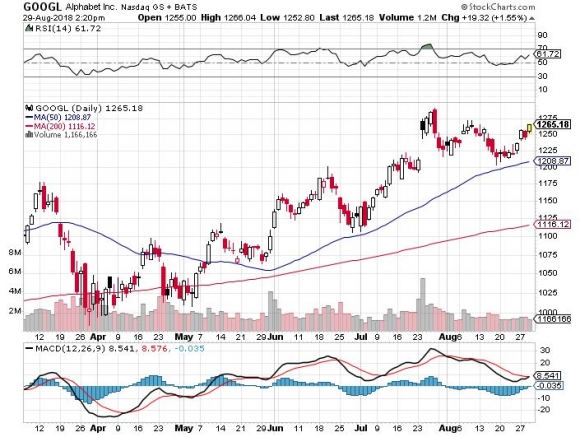
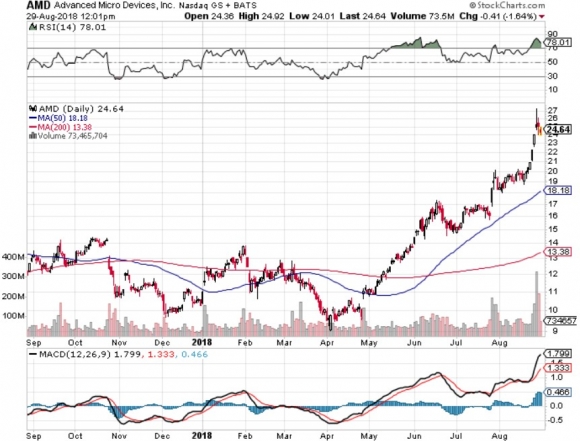
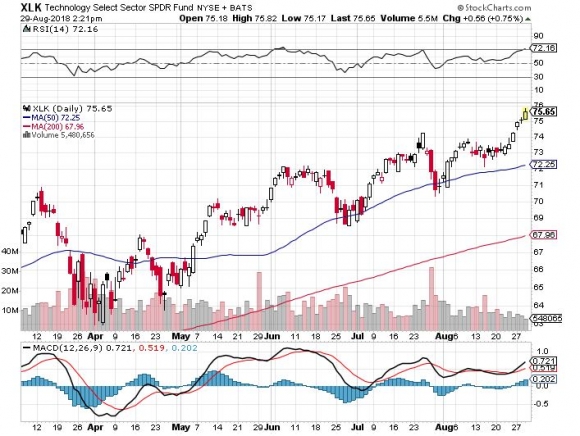
________________________________________________________________________________________________
Quote of the Day
“Technology itself is neither good nor bad. People are good or bad,” – said former CEO of InfoSpace, Inc. and cofounder of Moon Express Naveen Jain.
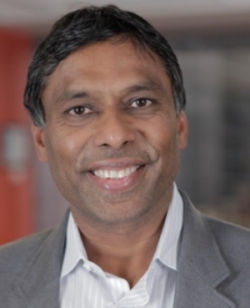
Mad Hedge Technology Letter
August 15, 2018
Fiat Lux
Featured Trade:
(HOW TO PLAY THE NEW FORTNITE GAMING FAD),
(ATVI), (EA), (AMD), (NVDA), (MSFT), (AAPL), (GOOGL), (TWTR), (SNAP), (FB), (SPOT), (GAMR)

Each generation grows up in its own unique environment.
Childhood experiences differ more and more as the world rapidly changes because of hyper-accelerating technology.
Millennials are usually defined as children born between 1981 to 1996.
They were the last generation to grow up outside breathing crisp, fresh air and meandering around the neighborhood with their friends looking for excitement.
Generation Z is the first generation in America generally raised indoors because of their overwhelming preference and broad-based addiction to technology.
Social media stocks have been a huge winner from this new paradigm shift in the behavior of young adults.
Instead of running around the block in packs, children are laser focused on these platforms communicating with the entire world and propping up their social lives.
Children meet a lot less than they used to and convening on a social media platform of choice has become the new normal.
Platforms such as Twitter (TWTR), Instagram and Snapchat (SNAP) have convincingly won over these new eyeballs even so much so that the new "going out" is congregating on Snapchat with a group of friends.
Facebook (FB) is now considered a legacy social media platform full of millennials and the older crowd.
Generation Z do not fancy drugs or drinking like the youth before them, rather, their panacea is video games and a lot of them.
These new societal trends will hugely affect your portfolio going forward.
A battle royal game is a video game category mixing the survival, exploration and scavenging elements together with last-man-standing gameplay.
These types of games predominantly contain 100 players sharing the same experience on a broadband connection.
This genre has been all the rage with PlayerUnknown's Battlegrounds (PUBG) piling up 400 million gamers across the globe selling 50 million copies of the game.
Of the 400 million gamers, 88% access the game via mobile devices highlighting the vigorous shift to mobile for younger generations.
PUBG made more than $700 million in sales in 2017.
The rise of the billion-dollar video games is alive and well.
In fact, Activision Blizzard (ATVI) stakes claim to eight gaming franchises commanding more than $1 billion in annual revenue with titles such as Overwatch, Candy Crush, and Call of Duty.
The popularity of video games will drive GPU manufacturers Nvidia (NVDA) and AMD (AMD) to new heights because gamers require high-quality GPUs to effectively game.
Nvidia CEO Jensen Huang even spouted that "the success of Fortnite and PUBG are just beyond comprehension" boosting GPU sales and capturing the imagination of global youth.
Fortnite, a "Hunger Games" style battle royal video game mirroring PUBG, has taken the world by storm in 2018.
This cultural juggernaut surpassed the 125 million gamer mark in just one year.
In February 2018, Epic Games, the maker of Fortnite, earned $126 million in one month, and it was the first time it passed PUBG in monthly sales.
In April 2018, it followed up monster February numbers by pulling in $296 million.
The growth trajectory is parabolic. Hold onto your hats.
Fortnite sparkles in the sunlight because its free-to-play model does not exclude anyone and is available on all devices.
At first, Fortnite was available for iOS customers and Samsung Android holders because it inked an exclusive deal with Samsung.
This week is the first week Epic Games is rolling out Fortnite to non-Samsung Android users with an interesting caveat.
The Android version of Fortnite bypasses Google Play (Google's app store on Android) preferring to sell the game direct for download from its official website.
This highlights that content is truly king.
Epic Games is betting the surge in popularity for its juggernaut game will sell itself.
This decision will cost Alphabet (GOOGL) $70 million per year in commission.
Apple makes it mandatory that any app downloaded to its devices must be downloaded from Apple's app store.
However, Android doesn't have the same requirements as its system is more functional, open, and a developer's dream.
Simply put, there are ways to download the game on Android without ever touching Google Play.
Going forward this could have a similar effect Spotify (SPOT) had on Wall Street on its IPO.
The middlemen or broker app could get bypassed in favor of direct sales.
Apple pockets commission on 30% of all in-app spending raking in around $60 million from Fortnite.
In-game add-on revenue is how Fortnite makes money from this free-to-play game.
The bulk of spending comes in the form of costumes better known as skins, where players pay to dress up their character in various garments selected for purchase.
The other revenue stream is a season subscription on sale for $10.
The tech sector has been migrating to subscription-based offerings and video games are no different.
This could play havoc with Alphabet's Google Play and Apple's app store down the line if prominent content producers choose to bypass their stores to sell directly.
The lack of video game exposure to the FANG group is mind-boggling. It seems they have their finger on the pulse of every other major trend in technology but have missed out on this one.
Microsoft (MSFT) is the closest FANG-like stock deep inside the video game ecosphere by way of its famous console Xbox.
In fact, Microsoft earns more than $10 billion per year from its gaming segment surpassing Nintendo at $9.7 billion per year.
This doesn't eclipse Sony's gaming revenue, which is $17 billion per year, but the 36% YOY growth in Xbox-related revenue signals its intent in the gaming industry that plays second fiddle to its cloud and software businesses.
Gaming is just a side business for Microsoft right now.
Ironically, Tencent has a 40% stake in Epic Games and is patiently waiting for government approval to sell Fortnite in China, which could be painstakingly arduous.
If Tencent gets the green light, Fortnite could develop into a monster business in 2018, and this is just the beginning.
Regrettably, Tencent has been mired in regulatory issues with the communist government reluctant to approve selling in-game products, which usually make up the bulk of revenue.
Recent blockbuster hit "Monster Hunter: World" was blocked by censors after debuting to great fanfare on August 8, 2018.
This title was expected to be one of the most popular video games of 2018.
Chinese state censors are on a short-term crusade to block the video game industry from receiving critical licenses and is the main reason for Tencent shares' headwinds.
Tencent shares peaked in January and are down almost 15% in 2018 because of uncertain gaming revenues.
Investors need to wake up and understand the gaming industry is about to mushroom because of demographics and the migration away from outdoor activity.
Following generations will have an even stronger bias toward technology-based indoor entertainment.
We are entering into the unknown of $4 billion per year video game businesses based on just one title and not one company.
Fortnite made PUBG's $700 million in revenue last year look paltry.
Gamers will soon see the rise of a $5 billion game franchise in 2019 and the sky is the limit.
This industry has growth, growth, and more growth and these single titles could surpass revenue of large semiconductor or hardware companies.
Don't underestimate the power of your child gaming away in your basement, he or she is part and parcel of a wicked tech growth driver about which not many people know.
Unfortunately, Epic Games is not a public company and shares cannot be purchased, but the success of Fortnite means that investors must pay heed to these new developments.
I am highly bullish on the video game sector and a big proponent of Activision (ATVI). A secondary name would be EA Sports (EA), which curates the Madden and FIFA franchises.
ATVI has felt the Fortnite effect in its share price selling off 11% because of investors' nervousness of Fortnite siphoning off ATVI gamers.
This short-term drop is a nice entry point into a solid video gaming company with various successful franchises that have withstood the test of time.
The 200-day moving average has provided ironclad support on the way up, and the Fortnite phenomenon won't last forever.
I would avoid the video game ETF ticker symbol GAMR because it includes one of my bona fide shorts - GameStop (GME).
It's mainly comprised of American, Japanese, and a Korean name but it would be sensible to focus on the companies with the highest quality comprehensive content.
The ETFs recent drop is also due to the strength of Fortnite.




________________________________________________________________________________________________
Quote of the Day
"Companies in every industry need to assume that a software revolution is coming." - said Silicon Valley venture capitalist Marc Andreessen.

Mad Hedge Technology Letter
August 9, 2018
Fiat Lux
Featured Trade:
(WHY SNAPCHAT IS GOING DOWN THE SOCIAL MEDIA DRAIN),
(SNAP), (FB), (NFLX), (AMZN), (GOOGL), (TWTR), (BB)

Companies this small should be growing.
Growth companies and tech go hand in hand, especially at the incubation stage where there is little resistance hindering growth.
The law of numbers dictate that small companies only need marginal gains to generate high growth in terms of percentages.
Once a company becomes as big as Amazon (AMZN), it becomes harder to move the needle.
Snapchat (SNAP), which is in the same social media game as Facebook, is vastly smaller than the incumbent that hoovers up the digital ad dollars.
Facebook (FB) boasts 1.47 billion daily active users (DAU) and is one of the members of a powerful digital ad duopoly along with Alphabet.
Snapchat added 4 million net (DAU)s in Q1 2018 and blew its chance for sequentially increasing usership by losing 4 million (DAU)s last quarter.
The stock sold off hard in after-hours trading, down 11% at one point but rebounded big time with the earnings commentary with Snapchat revealing guidance for the first time.
Snap opened the next trading day demonstrably lower reflecting the disenchantment of investors.
Evan Spiegel's creation has really had a hard go of it lately. The app redesign was a cataclysmic failure of epic proportions denting the popularity of this app.
The fallout was sacking 100 engineers.
Overall, there were some positive takeaways from the earnings report, mainly, the revenue beat was satisfying, and profitability shone through with average revenue per user (ARPU) shooting up 34% YOY.
Another victory was the boost in ad revenue, up 48% YOY, which is the main driver of revenue in the company.
The hairiest issue with this company is the fundamentals are excruciatingly apathetic.
Stagnating usership growth at this stage is a red flag.
Social media stocks were bashed in recent trading sessions with Twitter (TWTR) dropping from $46 to $31 because of diminishing usership and soft guidance.
The amount of monthly active users dropped from 338.5 million to 335 million, and financial guidance was brought down a few notches.
Twitter has made a poignant attempt to clean up its system from the debris molding around the edges.
To "improve the health" of the Twitter platform, Twitter purged 6% of all accounts rooting out the influences undesirable to its ethos.
Social media companies must take the initiative to protect its platforms, instead of being a silent bystander to a stabbing in a dark alley.
Facebook was the mother of all drops in the social media space collapsing from an all-time high of $218 to $171, a drop in one trading day.
Guidance tore apart this stock after a rapid run-up to the earnings report that saw unbelievable strength rising almost every day.
Poor guidance reflects the ill-effects of the recently enacted General Data Protection Regulation (GDPR), which tainted the European numbers.
The epicenter of data regulation has crimped profitability and popularity of social media in the Eurozone.
If Facebook and Twitter are facing tough short-term headwinds, then imagine how Snap feels.
They are the small fish in the big pond, and they are running out of places to hide.
Every new user Instagram picks up is one less potential user missed for Snapchat.
Let me remind you that Instagram is boosting its monthly average usership (MAU) 5% per year.
Instagram recently surpassed the 1 billion (MAU) mark after eclipsing the 800 million mark in September 2017.
Instagram added 200 million users, more than the entire (DAU) for Snap, in 11 months.
Big trouble for Snap.
Effectively, Snap is the inferior version of Instagram for young kids and that narrative does not bode well for the future.
For every $1 Snapchat spends, it earns -$6 on that $1. Kids aren't the biggest distributors of wealth. It would help if Snap matured its interface to accommodate older millennials who are tech savvy to boost its average revenue per user.
As it stands, Facebook earns $9 per daily active user while Snapchat earns a smidgeon over $1 per daily active user.
I cannot say that Facebook is a quality platform, but it has successfully monetized the platform.
What's more, CEO Evan Spiegel blamed the drop in usership on the redesign.
Yes, the redesign didn't help, but the usership would have dropped anyway because of draconian data laws in Europe and the general malaise stigmatized toward current social media platforms.
Management is not executing effectively at Snap, and it is out of touch with its core base without opening up new sources of growth.
If a company redesigns an app, enhance the app, do not make it unusable such as the Snap redesign.
Snap's eggs are all in one basket. And that basket is shrinking in the high revenue locations of North America and Europe.
It only earned $2 million from non-digital ad revenue.
As FANGs power on to pass a trillion dollars of market cap, the diversity in their segments are nothing short of impressive.
Snap has no other irons in the fire and is overly reliant in an industry in which it will slowly bleed to death.
The only savior is in reinventing itself, but that takes guts and a bold CEO with a revolutionary strategy.
There is precedence for this transformation such as BlackBerry (BB), one of the original smartphone makers, which has morphed into an autonomous driving technology company.
Another good example is Netflix, which started out in the DVD industry and pivoted to online streaming.
What Snap is doing has its limits and it needs to shake up its business model or slowly rot.
The company must wake up to the stark realization that its platform is not engaging.
Many analysts believed Snap could become half as big as Facebook and that seems highly unlikely.
I have been bearish on Snap for the entire existence of the Mad Hedge Technology Letter.
And it has been the perfect sell on the rallies stock because of its poor performance, even poorer management, and awful fundamentals.
A telltale sign was the last earnings call.
It was the second quarter in a row of blaming the redesign on bad performance.
If Spiegel underperforms next quarter again - meaning negative growth usership - it will be interesting if he blames the redesign again.
Third times a charm.
Where does this all lead?
Facebook offered to purchase Snapchat after its IPO because management was worried it would steal market share from Instagram.
Snapchat rebuffed the advances and decided to lock horns directly with Instagram.
Well, the David and Goliath battle is playing as most would assume, boding ill for the fate of Snapchat.
Instagram will keep weakening Snapchat moving forward. And Facebook might end up scooping up Snapchat down the road for a discount.
It doesn't look good for Snapchat, and investors should consider shorting this stock after a dead cat bounce.



________________________________________________________________________________________________
Quote of the Day
"The subscription model of buying music is bankrupt. I think you could make available the Second Coming in a subscription model and it might not be successful," - said former Apple cofounder Steve Jobs in a Rolling Stone interview, 2003.

Legal Disclaimer
There is a very high degree of risk involved in trading. Past results are not indicative of future returns. MadHedgeFundTrader.com and all individuals affiliated with this site assume no responsibilities for your trading and investment results. The indicators, strategies, columns, articles and all other features are for educational purposes only and should not be construed as investment advice. Information for futures trading observations are obtained from sources believed to be reliable, but we do not warrant its completeness or accuracy, or warrant any results from the use of the information. Your use of the trading observations is entirely at your own risk and it is your sole responsibility to evaluate the accuracy, completeness and usefulness of the information. You must assess the risk of any trade with your broker and make your own independent decisions regarding any securities mentioned herein. Affiliates of MadHedgeFundTrader.com may have a position or effect transactions in the securities described herein (or options thereon) and/or otherwise employ trading strategies that may be consistent or inconsistent with the provided strategies.
This site uses cookies. By continuing to browse the site, you are agreeing to our use of cookies.
OKLearn moreWe may request cookies to be set on your device. We use cookies to let us know when you visit our websites, how you interact with us, to enrich your user experience, and to customize your relationship with our website.
Click on the different category headings to find out more. You can also change some of your preferences. Note that blocking some types of cookies may impact your experience on our websites and the services we are able to offer.
These cookies are strictly necessary to provide you with services available through our website and to use some of its features.
Because these cookies are strictly necessary to deliver the website, refuseing them will have impact how our site functions. You always can block or delete cookies by changing your browser settings and force blocking all cookies on this website. But this will always prompt you to accept/refuse cookies when revisiting our site.
We fully respect if you want to refuse cookies but to avoid asking you again and again kindly allow us to store a cookie for that. You are free to opt out any time or opt in for other cookies to get a better experience. If you refuse cookies we will remove all set cookies in our domain.
We provide you with a list of stored cookies on your computer in our domain so you can check what we stored. Due to security reasons we are not able to show or modify cookies from other domains. You can check these in your browser security settings.
These cookies collect information that is used either in aggregate form to help us understand how our website is being used or how effective our marketing campaigns are, or to help us customize our website and application for you in order to enhance your experience.
If you do not want that we track your visist to our site you can disable tracking in your browser here:
We also use different external services like Google Webfonts, Google Maps, and external Video providers. Since these providers may collect personal data like your IP address we allow you to block them here. Please be aware that this might heavily reduce the functionality and appearance of our site. Changes will take effect once you reload the page.
Google Webfont Settings:
Google Map Settings:
Vimeo and Youtube video embeds:
